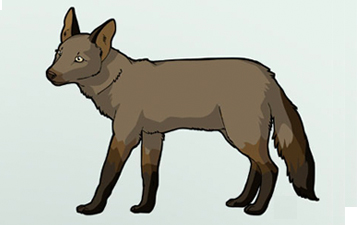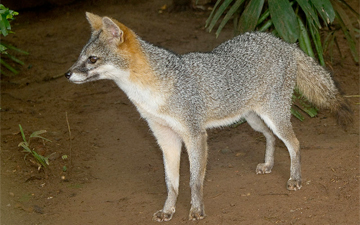The Crab-eating Fox (Cerdocyon thous), also known as the Forest Fox, Wood Fox, and the Common Fox, is an extant species of medium-sized canid endemic to the central part of South America and which appeared during the Pliocene epoch.[3] Cerdocyon comes from the Greek words kerdo (meaning fox) and cyon (dog) referring to the dog and fox- like characters of this animal.
The Crab-eating Fox is a canid that ranges in savannas, woodlands subtropical forests, prickly, shrubby thickets and tropical savannas such as the caatinga, llanos and campo. from Colombiaand southern Venezuela to Paraguay, Uruguay and Northern Argentina. (Eisenberg, 1999)
Its habitat also includes wooded river banks such as Riparian forest. In the rainy season their range moves uphill, whilst in drier times they move to low ground (Nowak, 1999). Their habitat covers all environments except rainforests, high mountains and open grassy savannas. In some regions of their range they are threatened with extinction.
The Crab-eating Fox searches for crabs on muddy floodplains during the wet season giving this animal its common name. It is an opportunist and an omnivore preferring insects or meat from rodents and birds when available. Other foods readily consumed include turtle eggs, tortoises, fruit, eggs, crustaceans, insects, lizards, crabs and carrion. Field analysis shows a food distribution of 25% rodents, 24.1% reptiles, 0.6% marsupials, 0.6% rabbits, 10.3% birds, 35.1% amphibians and 5.2% fish. Different studies during the rainy season in Venezuela showed a distribution of 54% insects and 20% vertebrates, changing in the dry season to 48% vertebrates, 31% crabs and 16% insects. Their diet is varied and differs in different investigations, suggesting opportunistic feeding and geographical variation. During the wet season the diet contains more crabs and crustaceans, while during the dry season it contains more insects (Berta, 1982; Pietrzak, 2007). The Crab-eating Fox contributes to the control of rodents and harmful insects.
(From Wikipedia, August 17th, 2010)
—
Generally, the crab-eating fox resembles the size and shape of most foxes. The coat is gray-brown on dorsally, with the face, ears, and legs reddish. The throat and underside of C. thous is white. The tips of the ears, tail, and legs are black.Cerdocyon thous has short, robust legs. The head and body length averages 643 mm and the average tail length is 285 mm (Berta, 1982). These foxes weigh between five and eight kg.
The crab-eating fox is nocturnal and lives in monogamous pairs (Eisenberg, 1999). They travel in pairs but hunt individually (Berta, 1982). Their home range varies between 0.6 to 0.9 km2 (Eisenberg, 1999). During the dry season, they tend to be more territorial than during the wet season, however overlap of territories is common (Nowak, 1995).
The habitat of Cerdocyon thous includes mostly savannahs and woodlands, however this species is known to inhabit a variety of other areas including edge and forested areas (Eisenberg, 1999). These foxes may use higher ground during the rainy season, and lowlands during the dry season (Nowak, 1999).
—





